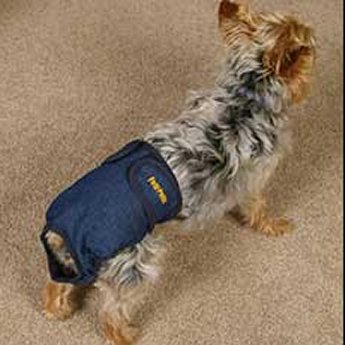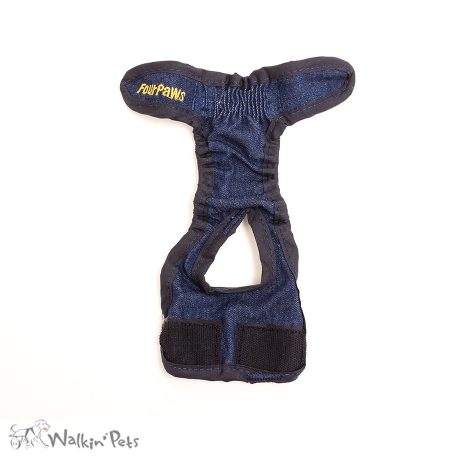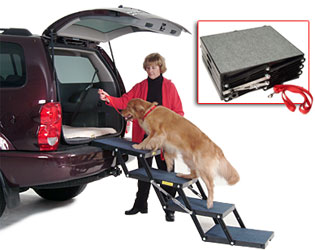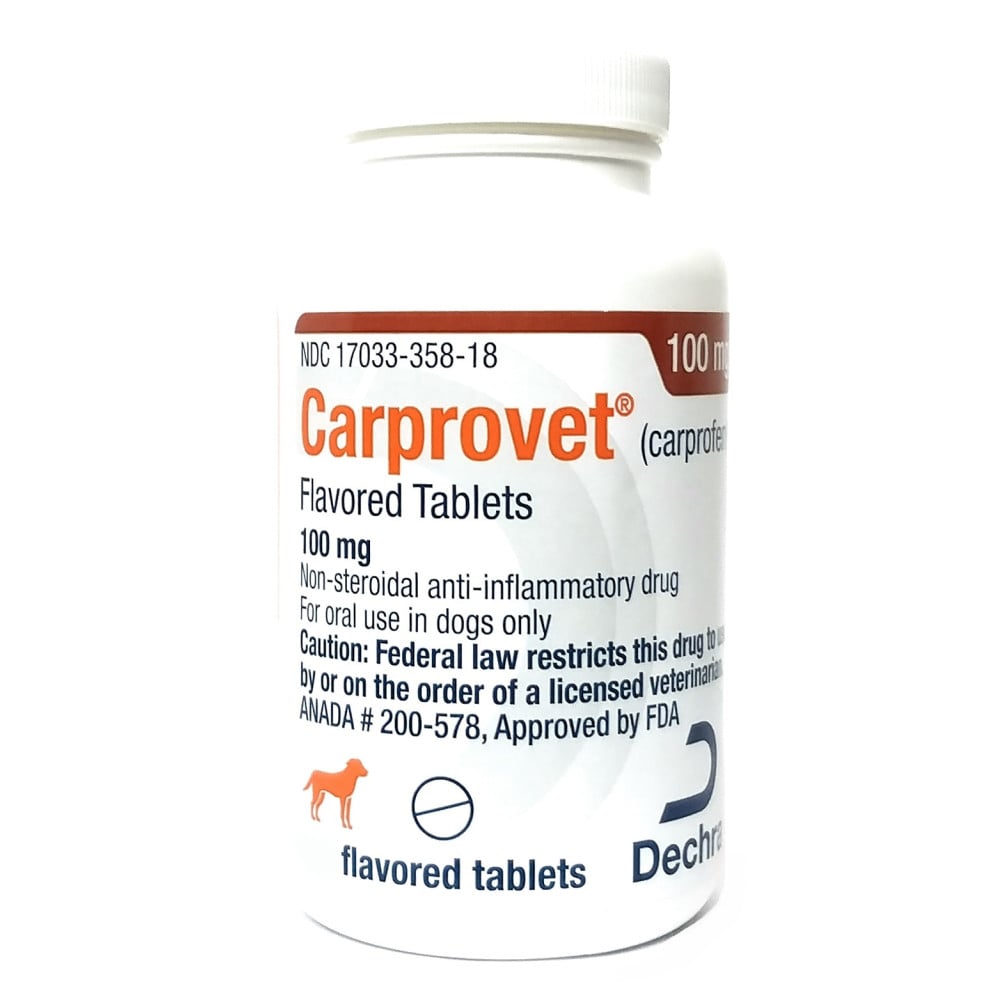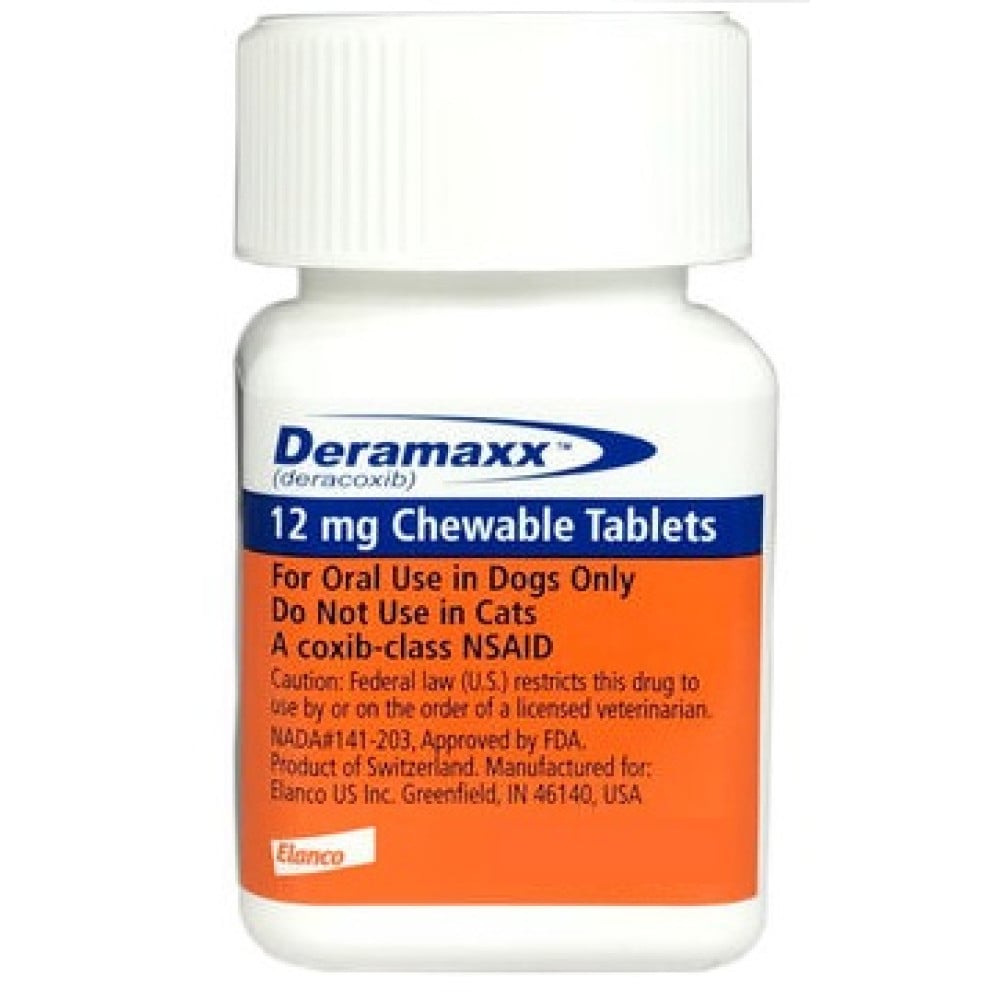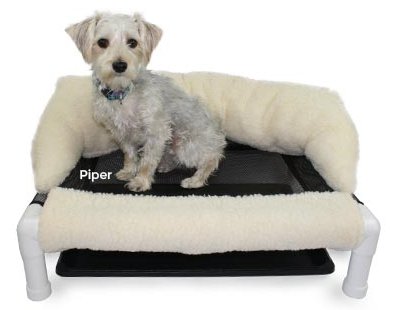Spinal Disabilities in Dogs
It's hard to remember when Hoover could walk - he was imobile for almost a year - but he was never a burden. We loved him too much! 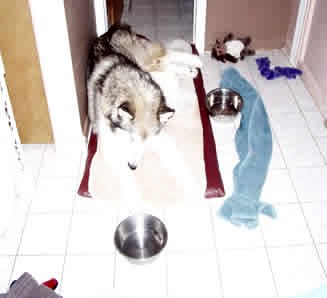
Spinal damage or hereditary disease leading to rear leg paralysis is a common problem in dogs. We've had several over the past 15 years. All were older guys, some with and some without additional problems. Many dogs are perfectly healthy in every other way, the spinal problem is their only issue so it seems sad to put them down if they are content with the lack of mobility. The dog will be normal from the point of the spinal injury upward and paralyzed from the point of the injury downward. If it is a genetic condition, such as Degenerative Myelopathy, the paralysis can slowly move forward, and create other problems such as stool and urinary incontinence. Rarely is rear paralysis temporary or "fixable" and management requires ongoing commitment. This article is not about hip dysplasia, though it can have many similar problems in a dog that cannot walk. Taking care of a disabled dog is not for everyone.Know what you're getting into. It's not for everyone.
Spinal issues can encompass many types of handicaps in dogs. Spinal cord degeneration, spondylosis in dogs, slipped discs, broken backs, various types of paralyzation, and spinal cord disease are among the problems you can encounter with a disabled dog who is injuried or has a genetic disease.. These problems may give the dog difficult mobility, incontinence, and further injuries from falling or decreased blood flow, and may require a specialist as a veterinarian to stay on top of things. Dogs with spinal injuries are dogs with special problems often requiring a unique kind of nursing care to prevent further damage to the spinal cord. A paralyzed dog or dog with spinal injuries must be fitted carefully with the correct equipment to minimize further damage to an already compromised spinal cord. Correctly fitted wheelchairs, slings and harnesses are a must.
The canine spine is divided into five sections. First, the cervical or neck portion consists of seven vertebrae (bones that make up the spinal column). The first cervical bone that connects to the base of the skull is called the atlas, and the second cervical bone is called the axis. These two bones are distinct from all other vertebrae in their shape. These bones, along with the other vertebrae of the spine, provide protection for the delicate spinal cord that runs through their center, while at the same time allow for some limited movement in the neck and back. The second section of the canine spine is called the thoracic spine and consists of 13 vertebrae. The 13 ribs connect on either side of the chest to these vertebrae. The third section is called the lumbar spine and consists of seven vertebrae that correspond to the "lower back" in people. Three fused vertebrae make up the unique section of the spine called the sacrum found in the pelvic part of the spine in dogs. The final section of the spine is made up of a varying number of vertebrae that become smaller and smaller as the tail tapers. These are called the coccygeal or tail portion of the spine. Vertebrae have projections called processes that extend up and laterally on the side. The processes are termed dorsal spinal processes and lateral spinal processes. They vary in length and shape depending upon where in the spinal column they are located. The dorsal spinal processes are the small ridges that can be felt running the length of the back. These are very useful in helping to count the vertebrae during examination.
Spinal column injuries can be devastating to an animal because any damage to the delicate spinal cord running through the center of the spine can result in permanent paralysis of portions of the body. Intervertebral disk disease, where the cushion-like disks in between the bones of the spine become deformed, Spinal issues in a dog that is accepting of his condition is difficult, but care is not unmanageable and can be quite rewarding. Care may be more difficult dealing with a demanding or high-strung dog.
Cleanliness and the Handicapped Dog
- If the dog is also urinary and fecal incontinent you have additional challenges - but they are not insurmountable. The dog, obviously, can't groom himself so it's important that the dog be bathed frequently. Even with frequent bathing, you will still smell urine or feces at times and bathing may be more difficult with a large dog. One solution we've found is to use a "walking strap" to help support the rear while the front end walks and allows the dog to walk to the bathtub where we rinse him off and clean him up. For dogs where the paralysis moves and affects the front legs as well, a sponge bath with dry shampoo and baby wipes or self-rinse shampoo may be an option. Also, a vynal stretcher can be used to get him to the bath tub (this will take 2 people). Expect to have to bathe the dog every few days at least to prevent urine scald on the skin and odor issues.
- If dry skin becomes a problem with frequent baths, a moisturizing rinse can be obtained from your vet.
- Be sure to maintain good flea control. You will need a waterproof product such as Frontline.
- Dry shampoo is available for spot cleaning.
- It's handy to have some rubber gloves for expressing urine or clean up. I've found the disposable sterile kind are best and fairly cheap for a box of 100.
- Shaving the area between the legs and in front of the penis is helpful in keeping the area clean and avoiding urine burn. If not kept clean, it will get like a bad sunburn and the hair will matt and may even come out at the root causing painful sores.
Zinc based creams (commonly used for diaper rash) on dogs is toxic if licked, so do NOT use this! Zinc oxide can cause intra vascular hemolytic anemia, gastrointestinal upset from direct irritation, and, potentially, multi organ failure.
 Baby wipes are especially handy in caring for the downer dog as is self-rinsing shampoo. It can be handy to know how to express the bladder so it does not become overfull. You can ask your veterinarian how to do this, it's not hard and will make your pet more comfortable. Basically, you put a hand on each side of the bladder and gently press, forcing urine out of the bladder. Be careful not to press too hard, as you can rupture the bladder with too much pressure. Disposable latex gloves can make this chore less yucky. A dog that's in pain may avoid voiding his bladder so it's important to look for signs of pain and treat them. If you know your pet well, you'll see it in the eyes, how he holds his head and he'll seem tired and possibly out of sorts.
Baby wipes are especially handy in caring for the downer dog as is self-rinsing shampoo. It can be handy to know how to express the bladder so it does not become overfull. You can ask your veterinarian how to do this, it's not hard and will make your pet more comfortable. Basically, you put a hand on each side of the bladder and gently press, forcing urine out of the bladder. Be careful not to press too hard, as you can rupture the bladder with too much pressure. Disposable latex gloves can make this chore less yucky. A dog that's in pain may avoid voiding his bladder so it's important to look for signs of pain and treat them. If you know your pet well, you'll see it in the eyes, how he holds his head and he'll seem tired and possibly out of sorts.
Under pads come in many sizes and have a padded side and a plastic waterproof side. These can be useful, but I've found they tend to slide and move under the dog unless he is not mobile at all. Also, though clean up is easier, it can get quite expensive for a big dog. If you can express the bladder onto a towel that is laundered, that's often a less expensive option. For our dogs I made a vynal bed that's about 2" thick - easy to move him on to, yet the foam inside gives him some padding. I also highly recommend buying a donut for your dog if there has been muscle loss. It will protect the delicate skin over the hip bones. Hoover appreciated it greatly and even tried to "aim" for it when we moved him. 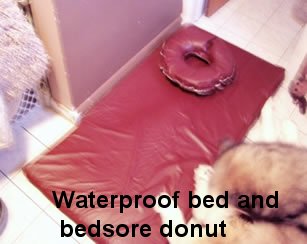
When it comes to protecting underlying flooring where the downer dog is bedded, nothing beats an office chair / floor protector or two. Heavy plastic can work, but tends to shift. I prefer locating the dog in an entryway with ceramic tile or an unused bathroom. At first, easy access to outdoors is important, but as the dog loses the ability to help, that becomes less important. Towels, blankets, dog bed, food that may spill, etc. can all safely be placed on the protector. I'm especially fond of rubber-backed rugs on a ceramic tile floor. The rugs are easy to launder and the tile floor is easy to mop. We've made a spot for the dog, protected from other dogs with baby gates, near the front door so he's easy to take in and out while he can still walk with his front legs. Thicker fluffy rugs are good at preventing pressure sores in larger dogs if layered and since most are nylon, so any urine tends to go through and not stay against the dog's skin.
Acupuncture can also be very helpful in helping control pain or muscle spasms in a dog with musculoskeletal problems.
Dealing with Other Pets
One thing often not considered is other pets in the household. Because dogs are a pack dog it's normal for them to want attack and possibly kill a weak dog, even if that dog was previously a good friend. While sometimes they are protective and caring of the disabled pet, often they are not. It is your responsibility to monitor your other pets and protect the weak dog if necessary. He should not have to live in fear of having to defend himself so it's important to use baby gates, pens or whatever is necessary to keep him safe from other household pets.
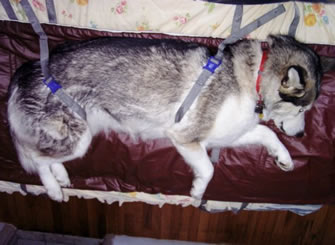
Home made stretcher
Dog Stretcher with safety straps is very handy for transporting the dog to a vet for checkups. Has strap handles as well as two poles for support. Easily cleaned vynal can be padded with rugs or towels to absorb accidents
The most important thing with an immobile dog is keeping him comfortable and warm. Water should always be accessible as kidneys may not be functioning well.
Symptoms of spinal injury:
- Unwillingness to jump.
- Pain and weakness in rear legs (lameness) Crying out in pain.
- Anxious behavior.
- Muscle spasms over back or neck.
- Hunched back or neck with tense muscles.
- Reduced appetite and activity level.
- Loss of bladder and/or bowel control (urinary and fecal incontinence, respectively)
It's also important to turn the dog often - lying on one side all the time will cause pressure or bed sores - just like in people. A dog without a lot of fat under the skin and short coat is more susceptible, but if the dog is immobile - you need to turn him often - it can only take a couple of hours for the circulation to slow and a red spot to appear. It sort of resembles a blood blister below the skin at first, but eventually, if not treated by removing the pressure can become a gaping hole. That's why it's important to rotate the dog often. A device I created that helps are hip pads. These vynal covered foam pads cushion the areas above bone and are adjustable and washable. If the dog has lost a lot of muscle, they can be helpful in preventing bedsores.
Allowing your dog to enjoy the outdoors in mild weather presents other problems. You should NOT leave a paralyzed dog outside in rainy, cold or hot weather as his ability to regulate his temperature and circulation is compromised. Urine or fecal odors or damaged skin will attract flies readily. He will not be able to shoo flies properly so it's imperative the dog be indoors and kept clean.. It only takes an hour on a hot day for fly eggs to turn into tissue eating maggots (a condition called "myiasis"). If the tissues are deeply invaded, death may result. Be sure your dog is not allowed to attract flies. Dogs are also at risk and can't defend himself when outdoors from roving dogs or coyotes. Make sure your dog is supervised or penned when outside. We've used a folding x-pen successfully for this purpose. (see photo) On a misty rainy day (not a downpour) this has worked well with a tarp over the top. Having malamutes, they want to be outside and this was a workable compromise. I do not recommend it for dogs susceptible to hotspots or that can't sit however.
Dog Bed Sores and Dog Skin Damaged from Dragging
The paralyzed dog will probably have some ability to drag him/herself or change positions somewhat but be aware of sores developing on pressure points. The areas that are especially vulnerable are elbows, ankles, and hips. If sores develop, see your vet for care. Special padding or bandage, as well as antibiotics for open sores, for these areas may be needed.Special support garments to prevent pressure sores on the elbows and joints of the legs can be ordered through www.dogleggs.com
A paralyzed dog may be very strong in the forelegs and move around with the rear quarters dragging. This can lead to scraped skin, especially if the dog does not have sensation to the rear limbs and cannot feel what would normally be quite painful. A strap is helpful for a cooperative dog and can allow him to "walk" almost anywhere - including up and down short stretches of stairs. Hoover didn't even know he was paralyzed for awhile, he would let out his "ninja yell" and strap under his belly, off we'd go. My legs became his legs. We were able to take a paralyzed dog on vacation with the use of the strap - and he was even able to explore sand dunes (until I got tired!) this way. He enjoyed his outing and did quite well though the entire vacation. Though it was a little more work than if he'd been a healthy dog, the joy of seeing him participate was well worth the trouble.
An orthopedic bed is a crucial investment for the "downer" dog. These beds are designed to protect pressure points from bed sores. If your vet’s office does not sell a product, they should be available through dog supply stores or on line. Outlets with good products include: www.greatcompanions.com and www.inthecompanyofdogs.com. When buying an orthopedic bed, be sure it is machine washable and it's important to have a second bed for use while one bed is in the laundry. It will not be helpful if only the cover of the bed is the only thing washable. A vynal covered bed will work, as long as it's waterproof.
Bladder care and infection prevention.
The "downer" dog is often inefficient at keeping the bladder empty. This predisposes the dog to the development of bladder infection problems which can move into the kidneys and cause infection there. Your dog may need periodic urine cultures to monitor for infection. If your dog will drink it, an occasional water bowl of cranberry juice can keep the bladder healthy. Check with your vet to see what the recommendation is for your particular dog. Bladder infections are easily eradicated with a simple antibiotic prescription. Some people are able to tell when an infection is present by a change in the odor or coloration of the urine. If you notice any changes, notify your vet at once.
dogs with spinal lesions at the level of the waist or higher will have excessive bladder tone (the so-called “upper motor neuron bladder”). This means that the bladder will need to be manually expressed by pressing or squeezing. Your vet can show you how to do this. Emptying the bladder should be done a minimum of 3 times daily. If the bladder is allowed to remain too full, it will stretch out and become flaccid. After a couple of weeks, the upper motor neuron bladder develops into an “automatic” bladder which will empty on its own. If the bladder has over-stretched in the first 2 weeks after the spinal injury it will not be able to empty itself when it develops the neurological capability to empty later on.
Spinal injuries of the lower back produce a “lower motor neuron bladder” which simply leaks and never has enough tone to fill. It is important not to assume that an dog can empty its own bladder simply because there is urine present in a diaper. The full bladder may simply be over-flowing. Regular emptying of the bladder is one of the best ways to prevent bladder infection.
Mobility
Mobility carts are especially important for the paralyzed dog who is strong in the front legs. A dog with a strong upper body will be able to run and exercise in a cart which is not only healthy but good psychologically as well. Some companies that make carts are www.k9carts.com , www.doggon.com, www.eddieswheels.com and my favorite Walkin Wheels for details and ordering. You can also make your own wheelchair economically for a big dog with an old wheelchair and some basic sewing ability. It's not hard and will give your dog some mobility with supervision outdoors. I've found they are too big for in the house (unless you have large rooms and doors). But it's great exercise and can keep your dog mobile longer because the muscles in his front will not atrophy as quickly.
Muscles are more comfortable when kept flexible. As long as there are no dislocations or healing fractures, passive flexion and extension and light massage are very good for the paralyzed limbs. The joints of the leg are moved through the full range of natural motion and relaxed. This is repeated for about 5-10 minutes 2-3 times daily.
Towel walking is also helpful physical therapy in keeping muscles flexible and strong. To accomplish towel walking, an appropriately sized towel is slipped under the belly and used as a sling. The dog is lifted so as to walk relatively normally in the front with the towel as support in back. As an alternative to the towel, we've found the dog medical equipment such as slings for lifting a dog to be much easier on our backs and there's something easier to grip because it has handles.
Keep in mind that a dog supported from the rear may be difficult to lead. A second person “steering” in front may be helpful or obtaining a harness with a front and back handle is helpful. Another possibility is teach your dog some new words and using commands he already knows. Having sled dogs - they already know gee (for left) and haw (for right) as well as other words that can be used for direction.
Care of the paraplegic or quadraplegic dog with spinal problems requires commitmen and education. If the dog is too big for one person to move, you'll need help. Getting the dog to the vet can be a major project. This is a situation where it's helpful to have a visiting vet or you can purchase or make a stretcher for this purpose. The stretcher pictured above has 2 poles for stability, extra handles and 2 "seatbelts" to keep the dog from trying to wiggle out while being moved. It still takes 2 people to lift a large dog - but the stretcher is quite helpful for larger dogs up to 120 lbs.
Good videos showing spinal cord injury in dogs.
Standard of Care for Spinal Disease in Dogs









